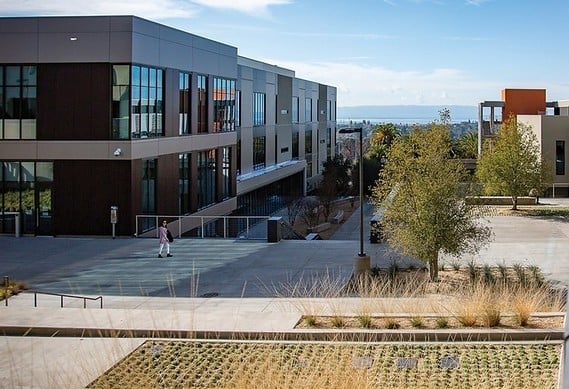You have /5 articles left.
Sign up for a free account or log in.

Students at Ohlone College’s two campuses can participate in the Junior Leadership Academy for career exploration and professional development.
Ohlone College/Flickr
Ohlone College in California takes professional development from the career center into the classroom with a semester-long program for career exploration and experiential learning.
The Junior Leadership Academy is an optional 15-week program allowing learners across the community college to engage in career exploration and receive paid internship experience. The content centers on the National Association of Colleges and Employers’ core competencies and provides students with a network and skills to promote success after graduation.
The background: The Junior Leadership Academy launched in 2020, inspired by a similar professional development curriculum for staff members at the college.
“We wanted to start something which had a focus on professional development, leadership, building core competencies,” explains Kelsey Bensky, program manager for career services and industry relations.
Ohlone’s career center is funded primarily from external sources, including federal workforce development funds, so the Junior Leadership Academy offered the university a way to utilize funding internally to support student internship experiences. This year, Ohlone and a majority of California’s public colleges opted in to the Learning-Aligned Employment Program (LAEP) through the California State Student Aid Commission, which funds student work experiences.
“Essentially, it’s funding that pays for student work experiences. It’s considered part of their financial aid package, but you pay it through wages,” Bensky says. The career center used different funding for the academy prior to this year but found it could fulfill the same work with LAEP.
LAEP has two requirements: students must be from underrepresented or disproportionately impacted communities, and most of their work must involve research. The JLA program satisfies both those requirements by incorporating industry research into the curriculum and recruiting students from underrepresented backgrounds.
The program: Students apply in the fall, providing answers to short essay questions about their career goals, interests and goals for themselves within the program. Staff members select participants by November, and the course sequence launches in January.
There’s no grade-level requirement for students, but most participants are second- or third-year students looking to transfer to a four-year institution, Bensky says.
The hybrid program has four segments: a credit-based course, a noncredit course, biweekly meetings and a paid microinternship.
Every other Friday, academy participants meet in person with the program coordinator to discuss NACE career competencies in an hour-and-a-half to two-hour session.
The noncredit course teaches students effective job search skills, Bensky says. “That course focuses more on the technical like résumé building, job searching, networking, that kind of thing, which allows the career adviser to focus on the NACE career competencies.”
Students also participate in a 75-hour microinternship starting in February, working with a business or nonprofit partner in their desired field as placed by the career center. Depending on the internship, students work remotely or in person on a single project and are paid $20 an hour by Ohlone. Sometimes students are grouped together, with two or three interns at the same site.
To receive internship credit, students enroll in a one-credit work experience course. Students without documentation or international students receive the same dollar amount as their peers in the form of a stipend.
Throughout the experience, career center staff serve as mentors to participants, providing a wraparound support model.
At the end of the term, students attend a program graduation ceremony and present PowerPoints in a showcase about their internship experiences, professional growth and personal development. This past year, Ohlone’s interim president spoke at the graduation, and a host employer served as the keynote speaker.
The impact: This past term, 17 students participated in the academy, 12 of whom were funded by the Learning-Aligned Employment Program. The other five received funding from the Ohlone College Foundation because they were ineligible due to citizenship requirements or other factors.
Eleven companies and organizations served as internship hosts across a variety of industries including nonprofits, social services, engineering, accounting and e-commerce, many located in the Tri-Cities near Ohlone’s campuses.
Ohlone staff issued a pre- and postsurvey to JLA participants to measure impact.
Prior to the experience, students lacked knowledge about internship and job recruitment, felt anxiety around working and had a lack of confidence in asking for feedback at work. Following the program, students said they built their professional network, learned résumé skills, grew their confidence in a work setting and gained teamwork and collaboration skills.
As a program, JLA offers equitable and accessible career development opportunities for learners at Ohlone, Bensky says, particularly in offering paid microinternships. For many first-generation or low-income students, establishing a professional network or finding paid work can be a challenge, and JLA breaks down those barriers.
In the future, Bensky hopes to expand opportunities for more students to participate in the academy to make it more inclusive and accessible.
Get more content like this directly to your inbox every morning. Subscribe here.




